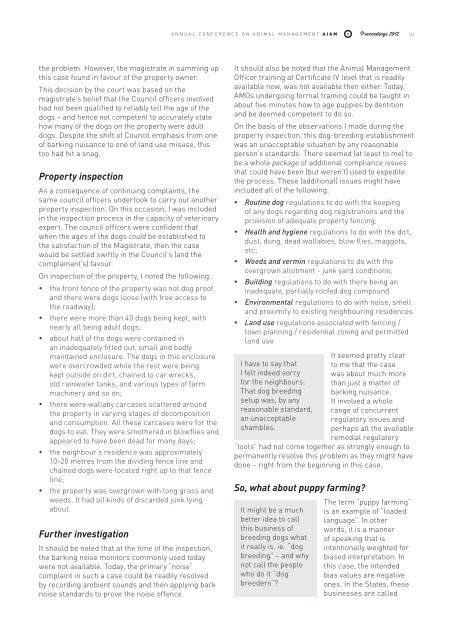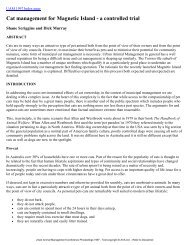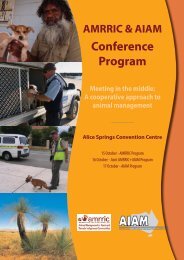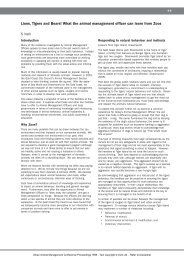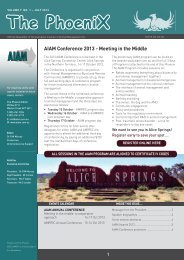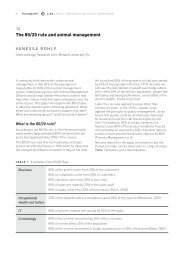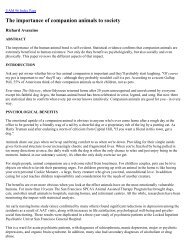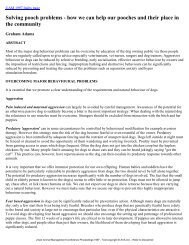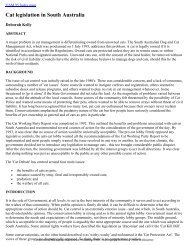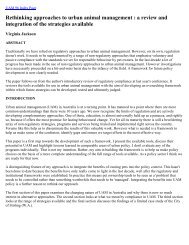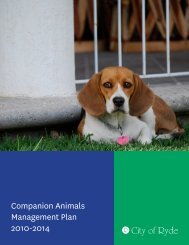Proceedings OF ThE - Australian Institute of Animal Management Inc
Proceedings OF ThE - Australian Institute of Animal Management Inc
Proceedings OF ThE - Australian Institute of Animal Management Inc
You also want an ePaper? Increase the reach of your titles
YUMPU automatically turns print PDFs into web optimized ePapers that Google loves.
Annual Conference on <strong>Animal</strong> <strong>Management</strong> AIAM <strong>Proceedings</strong> 2012 31<br />
the problem. However, the magistrate in summing up<br />
this case found in favour <strong>of</strong> the property owner.<br />
This decision by the court was based on the<br />
magistrate’s belief that the Council <strong>of</strong>ficers involved<br />
had not been qualified to reliably tell the age <strong>of</strong> the<br />
dogs – and hence not competent to accurately state<br />
how many <strong>of</strong> the dogs on the property were adult<br />
dogs. Despite the shift <strong>of</strong> Council emphasis from one<br />
<strong>of</strong> barking nuisance to one <strong>of</strong> land use misuse, this<br />
too had hit a snag.<br />
Property inspection<br />
As a consequence <strong>of</strong> continuing complaints, the<br />
same council <strong>of</strong>ficers undertook to carry out another<br />
property inspection. On this occasion, I was included<br />
in the inspection process in the capacity <strong>of</strong> veterinary<br />
expert. The council <strong>of</strong>ficers were confident that<br />
when the ages <strong>of</strong> the dogs could be established to<br />
the satisfaction <strong>of</strong> the Magistrate, then the case<br />
would be settled swiftly in the Council’s (and the<br />
complainant’s) favour.<br />
On inspection <strong>of</strong> the property, I noted the following:<br />
• ythe front fence <strong>of</strong> the property was not dog pro<strong>of</strong><br />
and there were dogs loose (with free access to<br />
the roadway);<br />
• ythere were more than 40 dogs being kept, with<br />
nearly all being adult dogs;<br />
• yabout half <strong>of</strong> the dogs were contained in<br />
an inadequately fitted out, small and badly<br />
maintained enclosure. The dogs in this enclosure<br />
were overcrowded while the rest were being<br />
kept outside on dirt, chained to car wrecks,<br />
old rainwater tanks, and various types <strong>of</strong> farm<br />
machinery and so on;<br />
• ythere were wallaby carcases scattered around<br />
the property in varying stages <strong>of</strong> decomposition<br />
and consumption. All these carcases were for the<br />
dogs to eat. They were smothered in blowflies and<br />
appeared to have been dead for many days;<br />
• ythe neighbour’s residence was approximately<br />
10-20 metres from the dividing fence line and<br />
chained dogs were located right up to that fence<br />
line;<br />
• ythe property was overgrown with long grass and<br />
weeds. It had all kinds <strong>of</strong> discarded junk lying<br />
about.<br />
Further investigation<br />
It should be noted that at the time <strong>of</strong> the inspection,<br />
the barking noise monitors commonly used today<br />
were not available. Today, the primary “noise”<br />
complaint in such a case could be readily resolved<br />
by recording ambient sounds and then applying bark<br />
noise standards to prove the noise <strong>of</strong>fence.<br />
It should also be noted that the <strong>Animal</strong> <strong>Management</strong><br />
Officer training at Certificate IV level that is readily<br />
available now, was not available then either. Today,<br />
AMOs undergoing formal training could be taught in<br />
about five minutes how to age puppies by dentition<br />
and be deemed competent to do so.<br />
On the basis <strong>of</strong> the observations I made during the<br />
property inspection, this dog-breeding establishment<br />
was an unacceptable situation by any reasonable<br />
person’s standards. There seemed (at least to me) to<br />
be a whole package <strong>of</strong> additional compliance issues<br />
that could have been (but weren’t) used to expedite<br />
the process. These (additional) issues might have<br />
included all <strong>of</strong> the following:<br />
• yRoutine dog regulations to do with the keeping<br />
<strong>of</strong> any dogs regarding dog registrations and the<br />
provision <strong>of</strong> adequate property fencing;<br />
• yHealth and hygiene regulations to do with the dirt,<br />
dust, dung, dead wallabies, blow flies, maggots,<br />
etc;<br />
• yWeeds and vermin regulations to do with the<br />
overgrown allotment - junk yard conditions;<br />
• yBuilding regulations to do with there being an<br />
inadequate, partially ro<strong>of</strong>ed dog compound<br />
• yEnvironmental regulations to do with noise, smell<br />
and proximity to existing neighbouring residences<br />
• yLand use regulations associated with fencing /<br />
town planning / residential zoning and permitted<br />
land use<br />
I have to say that<br />
I felt indeed sorry<br />
for the neighbours.<br />
That dog breeding<br />
setup was, by any<br />
reasonable standard,<br />
an unacceptable<br />
shambles.<br />
It seemed pretty clear<br />
to me that the case<br />
was about much more<br />
than just a matter <strong>of</strong><br />
barking nuisance.<br />
It involved a whole<br />
range <strong>of</strong> concurrent<br />
regulatory issues and<br />
perhaps all the available<br />
remedial regulatory<br />
“tools” had not come together as strongly enough to<br />
permanently resolve this problem as they might have<br />
done – right from the beginning in this case.<br />
So, what about puppy farming?<br />
It might be a much<br />
better idea to call<br />
this business <strong>of</strong><br />
breeding dogs what<br />
it really is, ie. “dog<br />
breeding” – and why<br />
not call the people<br />
who do it “dog<br />
breeders”?<br />
The term “puppy farming”<br />
is an example <strong>of</strong> “loaded<br />
language”. In other<br />
words, it is a manner<br />
<strong>of</strong> speaking that is<br />
intentionally weighted for<br />
biased interpretation. In<br />
this case, the intended<br />
bias values are negative<br />
ones. In the States, these<br />
businesses are called


